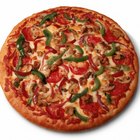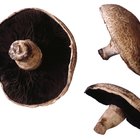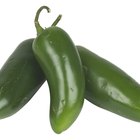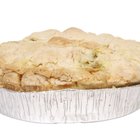
The corner pizzeria may make it look easy, but cooking a pizza evenly isn't always as simple as it looks. If your pizzas keep burning on the bottom before the toppings are fully cooked, you need to rethink your recipe and your prep. The problem isn't your oven -- it's what you're doing to the pizza before it ever goes in.
Overloaded Dough
Pizzas cook from the bottom up, so the more toppings you load onto your pie, the longer it takes for heat to radiate up through the crust to the top layers. If you slather your pizza in too much sauce, pile on too much cheese or add too many layers of other toppings, the crust will burn on the bottom before enough heat can pass through to the top. Resist the urge to layer on too many toppings -- a good rule of thumb is that no layer of toppings should completely obscure the previous layer. You should be able to see the crust through the sauce, the sauce through the cheese, and so on.
Toppings are Too Thick
Even if you don't add many toppings, if they're too thick and chunky, they won't cook fully or evenly before the crust starts to char. Meats like ham and pepperoni should be thinly sliced or diced, while thick vegetables -- such as bell peppers -- should be chopped up rather than sliced into thick chunks. Alternatively, saute thick vegetables, such as peppers and mushrooms, before topping your pizza with them. This gives them a partial cook before baking, and eliminates some of the moisture that could otherwise soak into the crust and make it soggy.
Dough is Too Thick
If the pizza dough is burning before the toppings are cooked, it isn't necessarily because of the toppings -- it may be because of the dough. If your dough is too thick, its outside will scorch before it can bake all the way through. When you roll out the dough, it shouldn't be any thicker than 1/8 inch.
Sticking to the Pan
Uncooked pizza dough is sticky, and if it sticks to the pizza stone or pan, it will burn. To prevent your dough from sticking and scorching, prepare it on a surface that has been dusted with flour or cornmeal. These form a protective layer on the bottom of the crust that keeps it from adhering to the stone or pan, and it typically burns off in the oven. You need only a lightly-dusted work surface, though, as too much flour or cornmeal will form a charred layer on the bottom of the crust.
Related Articles

How to Make Fabulous Pizza on a Gas ...

How Long to Bake a Pizza With Lots of ...

How to Cook the Perfect Burger Indoors ...

How to Bake Stuffed Portobello

How to Bake Pizza Dough So It Will Not ...

Is Whole-Wheat Pizza Healthy?

Can Pizza Be a Post-Workout Meal?

How to Freeze an Unbaked Pizza Crust

Things to Do With Prego Sauce

Can I Prepare Baked Brie Ahead of Time?
Can I Bake a Homemade Pizza on a Pan ...

How to Cook Hamburger Patties With ...

Cooking Pizza With Fresh Mozzarella

Papa John's Nutrition Facts for Whole ...

How to Grill With a Pizza Stone and ...

How to Bake Breaded Mahi Mahi

Baking Pizza With Wraps

Can Stuffed Jalapeno Poppers Be Frozen ...
How to Keep a Pie Crust From Bubbling ...

How to Pre-Bake Puff Pastry
References
Writer Bio
Tom Ryan is a freelance writer, editor and English tutor. He graduated from the University of Pittsburgh with a degree in English writing, and has also worked as an arts and entertainment reporter with "The Pitt News" and a public relations and advertising copywriter with the Carnegie Library of Pittsburgh.
Photo Credits
Steve Mason/Photodisc/Getty Images